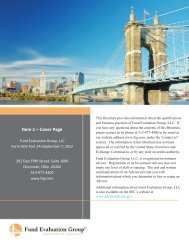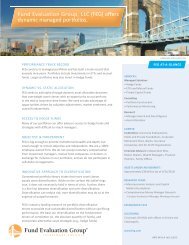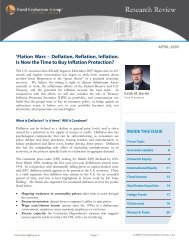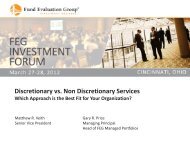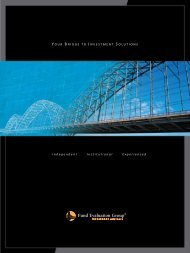Fallout from the Currency Wars - Fund Evaluation Group, LLC
Fallout from the Currency Wars - Fund Evaluation Group, LLC
Fallout from the Currency Wars - Fund Evaluation Group, LLC
You also want an ePaper? Increase the reach of your titles
YUMPU automatically turns print PDFs into web optimized ePapers that Google loves.
<strong>Fund</strong> <strong>Evaluation</strong> <strong>Group</strong><br />
2013 Investment Forum – Cincinnati, Ohio<br />
March 19, 2013<br />
<strong>Currency</strong> <strong>Wars</strong> and <strong>the</strong><br />
Future of <strong>the</strong> International<br />
Monetary System<br />
James Rickards<br />
Partner, JAC Capital Advisors, New York, NY USA
International Monetary<br />
System Today Dominated by<br />
<strong>Currency</strong> <strong>Wars</strong>. Definition of a<br />
<strong>Currency</strong> War:<br />
Devaluation of one country’s currency against<br />
that of ano<strong>the</strong>r in order to increase exports and<br />
economic growth<br />
Important to place in historical and economic<br />
context in order to understand today’s trends
<strong>Currency</strong> War I (1921-1936)<br />
Began with massive war reparations and war debts<br />
Weimar hyperinflation – 1921-1922<br />
French devaluation and gold exchange standard – 1925<br />
Fed policy blunders: Too loose 1927-28; too tight 1929-1931<br />
English devalue in 1931 / U.S. devalues in1933<br />
Tripartite Accord - 1936
<strong>Currency</strong> War II (1967-1987)<br />
Bretton Woods prevails beginning in 1944<br />
UK has massive overhang of Sterling claims <strong>from</strong> WWII<br />
U.S. Policy of “Guns and Butter” begins in 1965<br />
Bretton Woods begins to break down in 1967<br />
London Gold Pool 1961-1968<br />
Nixon Shock – 1971; Smithsonian Agreements<br />
Inflation, recession, oil shocks 1973 - 1979<br />
Volcker, Reagan and <strong>the</strong> return of “King Dollar” 1980-1984<br />
Plaza Accord 1985 and Louvre Accord 1987
<strong>Currency</strong> War III (2010 - )<br />
The Warning: Japan’s Lost Decade and LTCM<br />
The Prelude: Glass-Steagall, Swaps Repeal, VaR, Basel III<br />
Chinese export model meets U.S. consumption model<br />
Greenspan and Bernanke “puts”<br />
The Depression of 2007 and <strong>the</strong> Panic of 2008<br />
Aftermath: Debt, Depression and Deleveraging.....Again
Dynamics of <strong>Currency</strong> <strong>Wars</strong><br />
Attractions of <strong>Currency</strong> <strong>Wars</strong><br />
Stimulates net exports when <strong>the</strong>re are no o<strong>the</strong>r growth engines<br />
Generates inflation when banks won’t lend<br />
Steals growth <strong>from</strong> neighbors<br />
Requires no legislation or taxes<br />
Permanent rebalancing of terms of trade<br />
Downside of <strong>Currency</strong> <strong>Wars</strong><br />
Invites retaliation in beggar-thy-neighbor fashion<br />
Invites capital controls, withholding taxes, o<strong>the</strong>r tools<br />
Supply chains are complicated and diverse<br />
Increases prices for your imported components<br />
Inflation hurts growth in <strong>the</strong> long-run<br />
All advantage is temporary
Origins of a <strong>Currency</strong> War<br />
Examining Growth – Fiscal Policy<br />
Roots of <strong>Currency</strong> <strong>Wars</strong> are in debt, deleveraging, deflation<br />
The debt overhang impedes growth for a decade or more<br />
Fiscal Analysis<br />
GDP = C + I + G + (X – M)
Origins of a <strong>Currency</strong> War<br />
Monetary Drivers of Fed Policy<br />
Monetary Analysis<br />
PQ = Nominal GDP<br />
Q = Real GDP<br />
P = Inflation/Deflation<br />
M = Money supply<br />
V = Velocity of money<br />
MV = PQ
Fed Expansion of U.S. Money Supply<br />
QE1<br />
QE2
Velocity of Money Both Volatile and<br />
Declining Sharply<br />
Velocity is collapsing
Fed Must Bend <strong>the</strong> Velocity Curve<br />
Changing Velocity is a Socio-Psychological Task<br />
Primary Tools are:<br />
Negative Real Interest Rates<br />
e.g. Nominal Rates of 2% and Inflation of 4% =<br />
Real Interest Rate of -2%<br />
Inflation Expectations Shock<br />
e.g. Expectations of 2% inflation and actual inflation<br />
of 4% causes an inflationary shock<br />
Both Tools Require 4% Inflation
How Does Fed Achieve 4% Inflation?<br />
✔ Cutting Interest Rates (2007)<br />
✔ Quantitative Easing (2008)<br />
✔ Communications Policy (2008)<br />
✔ <strong>Currency</strong> <strong>Wars</strong> (2010)<br />
✔ Operation Twist (2011)<br />
✔ Nominal GDP Targets (2012)<br />
✔ Try Harder (2013)
Monetary Math is Easy!<br />
1 + 4 = 5<br />
4 + 1 = 5<br />
Nominal debt requires nominal GDP growth
The G4 Solution to <strong>Currency</strong> <strong>Wars</strong> –<br />
U.S., UK, Japan, Europe Ease Toge<strong>the</strong>r<br />
Problems: Europe, Emerging Markets, Inflation
What Could Possibly Go<br />
Wrong?
Fed Misapprehends <strong>the</strong> Statistical Properties<br />
of Risk in <strong>Currency</strong> and Capital Markets<br />
Fed and o<strong>the</strong>r central banks persist in using equilibrium models<br />
Evidence for complexity and non-equilibrium states is convincing
Are Capital Markets Complex Systems?<br />
Diversity<br />
Connectedness<br />
Interaction<br />
Adaptability
Characteristics of Complex Systems<br />
Emergent Properties<br />
Phase Transitions<br />
Critical State Dynamics<br />
Power Law Distribution
Comparison of Normally Distributed Events to<br />
Power Law Distribution,<br />
Bell Curve and Power Curve –<br />
Decay, Tails and Truncation<br />
Bell Curve<br />
Power Curve
Sub-Critical and Critical States<br />
Assume 100 People repudiate <strong>the</strong> dollar in each case<br />
in total population of approximately 310,000,000 people.<br />
T = Critical Threshold for each cohort<br />
Case 1<br />
Sub-critical State<br />
1,000 people / T= 500<br />
1 million people / T = 10,000<br />
10 million people / T = 100,000<br />
100 million people / T= 10 mil.<br />
200 million people / T = 50 mil.<br />
Case 2<br />
Critical State<br />
1,000 people / T= 100<br />
1 million people / T = 1,000<br />
10 million people / T = 100,000<br />
100 million people / T= 10 mil.<br />
200 million people / T = 50 mil.
How Connected are we? How close to <strong>the</strong> Critical State?<br />
Source: Professor Eve Mitleton-Kelly, London School of Economics. Used with permission.
FX Trading & Investment Implications<br />
Bizarre Love Triangle – USD/CNY, USD/EUR, EUR/CNY<br />
Key to understanding Euro strength<br />
Key to understanding QE3 or NGDP Targeting<br />
US provides liquidity<br />
via swap lines<br />
Germany vs. Periphery<br />
€<br />
$ ¥<br />
Political fight about inflation & unemployment<br />
China provides solvency<br />
via bond purchases
Possible Solution to Euro Dilemma:<br />
Convergence of Unit Labor Costs between<br />
Germany and <strong>the</strong> Periphery<br />
Periphery Labor Costs<br />
German Labor Costs<br />
Periphery Labor Costs<br />
German Labor Costs<br />
Case 1<br />
Case 2<br />
Extreme Deflation for Periphery<br />
Mild Inflation for Germany<br />
Look for ECB rate cuts, higher inflation in Germany. Whi<strong>the</strong>r <strong>the</strong> Euro?
Recent Developments in <strong>the</strong> <strong>Currency</strong> <strong>Wars</strong><br />
IMF Rescue of Europe Depends on SDR Debt, Global Participation<br />
U.S. Launches Financial War or Iran – SWIFT – Iranian Response<br />
Nigeria to Allocate 10% of Reserves (USD4 billion) to CNY<br />
BRICS announce plan to launch new development bank<br />
Rumors of a War – Iran, Israel, Russia, Turkey Syria and <strong>the</strong> U.S.
China: Between <strong>the</strong> Rock of Inflation and <strong>the</strong><br />
Hard Place of Unemployment<br />
China can have any GDP it wants if it has debt capacity<br />
SOES can “invest” <strong>the</strong>ir way to growth – but most is wasted<br />
Rebalancing to consumer implies state sector must drop sharply<br />
But if state sector declines sharply, how do you “pay off” cronies?<br />
<strong>Currency</strong> wars a form of ease – China turns this on and off
<strong>Currency</strong> <strong>Wars</strong> Lessons for<br />
Emerging Markets Currencies<br />
Pegging to US Dollar imports inflation <strong>from</strong> US due to QE<br />
Allowing currency to appreciate weakens export competitiveness<br />
Ei<strong>the</strong>r inflation or appreciation increases unit labor costs<br />
Countries may choose to permit inflation to protect jobs, exports<br />
The US will not relent in currency wars; expect global inflation
Australia: Watch for strength in AUD/USD and<br />
AUD/EUR<br />
Chinese flight capital will give AUD/CNY a boost<br />
China may continue to import even with slower growth<br />
Don’t underestimate U.S. desire to fight and win “currency wars”<br />
Australia’s easing and currency deval may start to import inflation<br />
Use of AUD as a reserve currency and trade currency will grow
Japan: An Exception that Proves <strong>the</strong> Rule<br />
Japan is aggressively weakening JPY to promote exports<br />
Given Japan’s demography & resources, it has few options<br />
The U.S. will give Japan a “pass” in <strong>the</strong> currency wars – to a point<br />
The U.S. has geopolitical motives to help Japan beyond trade<br />
Japan has to work hard to overcome flight to quality
The Future of <strong>the</strong> International<br />
Monetary System<br />
Multiple Reserve Currencies<br />
Gold<br />
SDR’s<br />
Chaos
A World of Multiple Reserve Currencies<br />
Reprises 1920’s and 1930’s per Barry Eichengreen<br />
U.S. Dollar Declined <strong>from</strong> 70% to 60% of Global<br />
Reserves between 2000 and 2012<br />
Future Reserve Mix could be 35% USD, 35% EUR,<br />
10% JPY, 20% GBP, CNY, CHF, CAD, AUD, o<strong>the</strong>r<br />
Dynamically unstable without an anchor<br />
Solves no problems, creates new one
The SDR Solution<br />
Introduced 1969. Issued in 1972, 1981, 2009<br />
Obviated in 1980’s by commercial banks<br />
Preferred path of <strong>the</strong> power elites<br />
Ten-year plan includes issuers, buyers, dealers, repo,<br />
derivatives and new allocations<br />
SDR’s will not be local currency, but used for oil, global<br />
corporations, balance of payments<br />
Turns IMF into proto-world central bank with currency and<br />
expanded balance sheet
A New Gold Standard<br />
What is a Gold Standard?<br />
What is <strong>the</strong> proper measure of Money?<br />
What is <strong>the</strong> proper reserve ratio?<br />
Which nations are included?
Metric Tonnes<br />
9,000<br />
8,000<br />
7,000<br />
6,000<br />
5,000<br />
4,000<br />
3,000<br />
2,000<br />
1,000<br />
0<br />
8,133<br />
United<br />
States<br />
Official Gold Holdings – Total 30,731 Metric Tonnes<br />
3,406<br />
2,966<br />
2,451 2,435<br />
1,054 1,040 937<br />
Germany IMF Italy France China Switzerland Russia Japan All O<strong>the</strong>rs<br />
765<br />
7,544
Metric Tonnes<br />
12,000<br />
10,000<br />
8,000<br />
6,000<br />
4,000<br />
2,000<br />
0<br />
Holdings with Eurosystem – Total 30,731 Metric Tonnes<br />
10,798<br />
8,133<br />
Eurosystem United<br />
States<br />
2,966<br />
1,054<br />
1,040 937<br />
765<br />
557 423<br />
5,098<br />
IMF China Switzerland Russia Japan India Taiwan All O<strong>the</strong>rs
USD per Ounce of Gold<br />
50,000<br />
45,000<br />
40,000<br />
35,000<br />
30,000<br />
25,000<br />
20,000<br />
15,000<br />
10,000<br />
5,000<br />
0<br />
Gold Prices Based on U.S. Monetary<br />
Aggregates<br />
$2,590<br />
$6,475<br />
$12,347<br />
$30,868<br />
M1 (.40) M1 M2 (.40) M2
USD per Ounce of Gold<br />
50,000<br />
45,000<br />
40,000<br />
35,000<br />
30,000<br />
25,000<br />
20,000<br />
15,000<br />
10,000<br />
5,000<br />
0<br />
Gold Prices Based on Global Monetary<br />
Aggregates<br />
(US, ECB, China)<br />
$6,993<br />
$17,482 $17,820<br />
$44,552<br />
GM1 (.40) GM1 GM2 (.40) GM2
What Happens When Gold is <strong>the</strong> Numeraire?<br />
The S&P500 Index in Gold Ounces
Chaos
Thank you<br />
James Rickards, Partner<br />
JAC Capital Advisors <strong>LLC</strong>, New York, NY USA<br />
james.rickards@gmail.com<br />
@JamesGRickards



